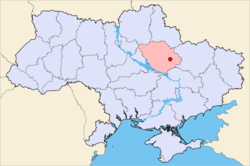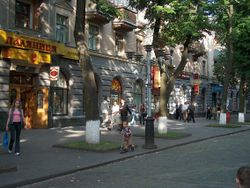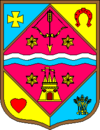Poltava
| Poltava Полтава |
|||
|---|---|---|---|
|
|
|||
|
|||
 |
|||
| Coordinates: | |||
| Country Oblast Raion |
Poltavskyi Raion |
||
| Founded | 8991 | ||
| Government | |||
| - Mayor | Andriy Matkovsky | ||
| Area | |||
| - Total | 103.0 km2 (39.8 sq mi) | ||
| Elevation | 132 m (433 ft) | ||
| Population (2005) | |||
| - Total | 308,509 | ||
| - Density | 2,995/km2 (7,757/sq mi) | ||
| Postal code | 36000—36499 | ||
| Website | Official website in English | ||
| 1The previously believed foundation date was 1174. | |||
Poltava (Ukrainian: Полтава, Russian: Полтава) is a city in central Ukraine. It is the administrative center of the Poltava Oblast, as well as the administrative center of the surrounding Poltavskyi Raion within the oblast. The city itself is also designated as its own separate raion within the oblast. The current estimated population is 313,400 (as of 2004). The city lies on the banks of the river Vorskla.
Contents |
History
It is still unknown when the city was founded. Baltavar Kubrat's grave was found in its vicinity, and its name derives from the title he, his predecessors and his successors bore. Though the town was not attested before 1174, municipal authorities chose to celebrate the town's 1100th anniversary in 1999, for reasons unknown. The settlement is indeed an old one, as archeologists unearthed a Paleolithic dwelling as well as Scythian remains within the city limits.
The present name of the city is traditionally connected to the settlement Ltava which is mentioned in the Hypatian Chronicle in 1174. The region belonged to the Grand Duchy of Lithuania from the 14th century. The Polish administration took over in 1569. In 1648 Poltava was captured by the Ruthenian-Polish magnate Jeremi Wiśniowiecki (1612-51). Poltava was the base of a distinguished regiment of the Ukrainian Cossacks and served as a Cossack stronghold during the Khmelnytsky Uprising. After the pro-Polish hetman Ivan Vyhovsky came to power and a civil war broke out, Poltava in the year 1658 under polkovnyk Martyn Pushkar was the leading town of the rebells, but was ultimately burned down and pillaged by the troops of Vyhovsky while many of its women and children were enslaved by the Crimean Tatars. In 1667 the town passed to the Russian Empire.
In the Battle of Poltava on June 27-28, 1709 (Old Style), or 8 July (New Style), tsar Peter the First, commanding 53,000 troops, defeated a Swedish army of 19,000 troops led by Field Marshal Carl Gustaf Rehnsköld (who had received the command of the army after the wounding of the Swedish king Charles XII on June 17). "Like a Swede at Poltava" remains a simile for "completely defeated" in Russian. The battle marked the end of Sweden as a great power and the rise of Russia as one.
In 1775, Poltava's Monastery of the Exaltation of the Cross (Russian: Крестовоздвиженский монастырь, Krestovozdvizhensky Monastyr) became the seat of bishops of the newly created Eparchy (Diocese) of Slaviansk and Kherson. This large new diocese included the lands of the Novorossiya Governorate and Azov Governorate north of the Black Sea. Since much of that area had been only recently conquered by Russia from the Ottoman Empire, and a large number of Orthodox Greek settlers had been invited to settle in the region, the Imperial Government picked a renowned Greek scholar, Eugenios Voulgaris to preside over the new diocese. After his retirement in 1779, he was replaced by another Greek theologian, Nikephoros Theotokis. [1][2]
In World War II, after the Red Army had cleared the Wehrmacht out of the Eastern Ukraine by the end of 1943 during the Dnieper–Carpathian Offensive, by the summer of 1944 the allied USAAF conducted a number of shuttle bombing raids against the Third Reich under the name of Operation Frantic, and used purpose-built bases in the Poltava area, as well as near Myrgorod, as eastern locations for landing B-17 Flying Fortress heavy bombers involved in those operations.
Sights
The centre of the old city is a semicircular Neoclassical square with the Tuscan column of cast iron (1805-11), commemorating the centenary of the Battle of Poltava and featuring 18 Swedish cannons captured in that battle. As Peter the Great celebrated his victory in the Saviour church, this 17th-century wooden shrine was carefully preserved to this day. The five-domed city cathedral, dedicated to the Exaltation of the Cross, is a superb monument of Cossack Baroque, built between 1699 and 1709. As a whole, the cathedral presents a unity which even the Neoclassical belltower has failed to mar. Another frothy Baroque church, dedicated to the Dormition of the Theotokos, was destroyed in 1934 and rebuilt in the 1990s.
Administrative divisions
The city is divided into three raions, or districts.
- Oktiabrskiy (Zhovtneviy) raion, to the south-west with an area of 2077 hectares and a population of 147,600 in 2005. It's a largely residential area combining the Almazniy, Ognivka, Sadi-1 and Sadi-2 neighbourhoods, and also includes the city centre.
- Kyivskiy raion, is the largest by area, comprising 5437 hectares, or 52.8% of the city total situated in the north and north-west. Its census in 2005 was 111,900. This district has a large industrial zone and includes
- Leninskiy raion, to the east and south-east, in the valley of the Vorskla river, with an area of 2988 hectares and a population of 53,700 in 2005.
The villages of Rozsoshenci, Shcherbani, Kopili and Suprunivka are officially considered to be settlements outside the city, but actually constitute a part of Poltava agglomeration.
Transport and infrastructure

Transportation in Poltava is well-developed. The city has two major railway stations, and railway links with the cities of Kiev, Kharkiv, Kremenchuk and Krasnograd. The lines towards Kiev and Kharkiv are electrified and are used by an express train, a regular service with comfortable carriages. Electrification of the Poltava-Kharkiv line was completed in August 2008.[3] Avtovokzal is the city's intercity bus station. Buses for local municipal routes depart from "AC-2" (autostation #2 - along Shevchenko street) and "AC-3" (Zinkivska street).
City transportation is represented by the following:
- trolleybuses with fifteen routes and a network of 72.6 km;
- buses, including a ringroad routes (#19,20,21);
- marshrutkas on all bus routes.
Ticket prices for that kinds of city transport are respectively 0.75 UAH, 1.00 UAH and 1.25 UAH (as of June 2009).
Poltava has a domestic airport, situated in 5 km west outside the city limits near the village of Ivashki. The international highway M 03 (E40), which links Poltava with Kiev and Kharkiv, passes through the southern outskirts of Poltava city. There is also a regional highway P-17 crossing Poltava and linking it with Kremenchuk and Sumy.[4]

Education and science
Poltava has always been one of the most important science and education centres in Ukraine. Major universities and institutions of higher education include the following:
- Poltava Pedagogical State University named after V. G. Korolenko
- Poltava National Technical University named after Yuri Kondratyuk
- Poltava Agrarian State Academy
- Ukrainian Medical Stomatological Academy (UMSA)
- Poltava University of Consumer Cooperatives in Ukraine
- Poltava Military Institute of Connections
- Poltavian Faculty Of National Juridical Academy Of Ukraine
Astronomy
- Poltava gravimetric observatory (PGO) is situated a bit north from city centre (27-29 Miasoyedov St.). Its main work directions are measurements of Earth rotation, latitude variations (applying zenith stars observations, lunar occultation observations and other)
- Observational station of PGO in rural area, some 20 km east along the M03-E40 highway. Radiotelescope URAN-2 (Ukrainian: УРАН-2) is situated there too.
Famous people from Poltava and its region
- Marie Bashkirtseff — 19th c. Parisian painter, memoirist
- Yitzhak Ben-Zvi — a historian, Labor Zionist leader, and the second and longest serving Israeli president.
- Hanka Bielicka — Polish actress
- Andriy Danylko — Ukrainian singer
- Nikolai Gogol — writer and playwrighter
- Alexander Gurwitsch — Russian physician and biologist
- Ivan Kotlyarevsky — Ukrainian writer, poet and playwright
- Anatoliy Vasilievich Lunacharsky — Russian Marxist revolutionary and the first Soviet People's Commissar of Enlightenment responsible for culture and education
- Ivan Paskevich — Ukrainian military leader in the Russian service
- David Peikoff — Canadian-U.S. Deaf Rights advocate, born on March 21, 1900, in Yanoschina, Poltava Province — former Russia.
- Zhanna Prokhorenko — Ukrainian actress
- Sasha Putrya — Ukrainian artist
- Maria Tarnowska (born Maria Nikolaevna O'Rourke) — famous femme fatale, whose trial for murder (Venice, 1910) attracted worldwide media attention.
- Vera Kholodnaya — an outstanding Ukrainian actress, the first star of Russian silent cinema
- Yuri Kondratyuk (born Olexandr Gnatovich Shargei) — a pioneer of astronautics and spaceflight who, in the early twentieth century, foresaw ways of reaching the moon.
- Panas Myrny (born Panas Yakovych Rudchenko) — Ukrainian writer (* Panas Myrny's Memorial estate)
- Mikhail Vasilievich Ostrogradsky — Ukrainian mathematician, mechanician and physicist.
- Hryhorii Skovoroda — Ukrainian poet, philosopher and composer.
- Symon Petliura — Ukrainian politician and statesman, a leader of Ukraine's fight for independence following the Russian Revolution of 1917.
- Nikolai Yaroshenko — Russian painter of Ukrainian origin.
- Svetlana Kopchikova — Ukrainian swimmer and 200 m medley champion at the 1985 Summer Universiade.
- Mikhail Zoshchenko — Soviet satirist.
Sports
The most popular sport is football. Two professional football teams are based in the city: Vorskla Poltava in the Ukrainian Premier League and FC Poltava in the Druha Liha. There are 3 stadiums in Poltava: Butovsky Vorskla Stadium (main city stadium) and 'Dynamo' are situated in the city centre and 'Lokomotiv' which is situated in Podil district.
Honors
A minor planet 2983 Poltava discovered in 1981 by Soviet astronomer Nikolai Stepanovich Chernykh is named after the city.[5]
References
- ↑ Евгений Булгарис (Eugenios Voulgaris's biography) (Russian)
- ↑ Никифор Феотоки (Nikephoros Theotoki's biography) (Russian)
- ↑ "Poltava-Kharkiv rail line". http://gortransport.kharkov.ua/news/news.php?news_id=7022. Retrieved September 21, 2008.
- ↑ Полтава - План Схема. Киевская Военно-Картографическая Фабрика
- ↑ Schmadel, Lutz D. (2003). Dictionary of Minor Planet Names (5th ed.). New York: Springer Verlag. pp. 246. ISBN 3540002383. http://books.google.com/books?q=2983+Poltava+RW2.
External links
- meria.poltava.ua — Official website of Poltava
- Virtual museum of Poltava in Russian language
- Writer from Poltava Tatiana Zadorozhna
- Poltava history in Russian, Ukrainian, English language
|
||||||||||||||||||||
|
|||||||||||||||||
